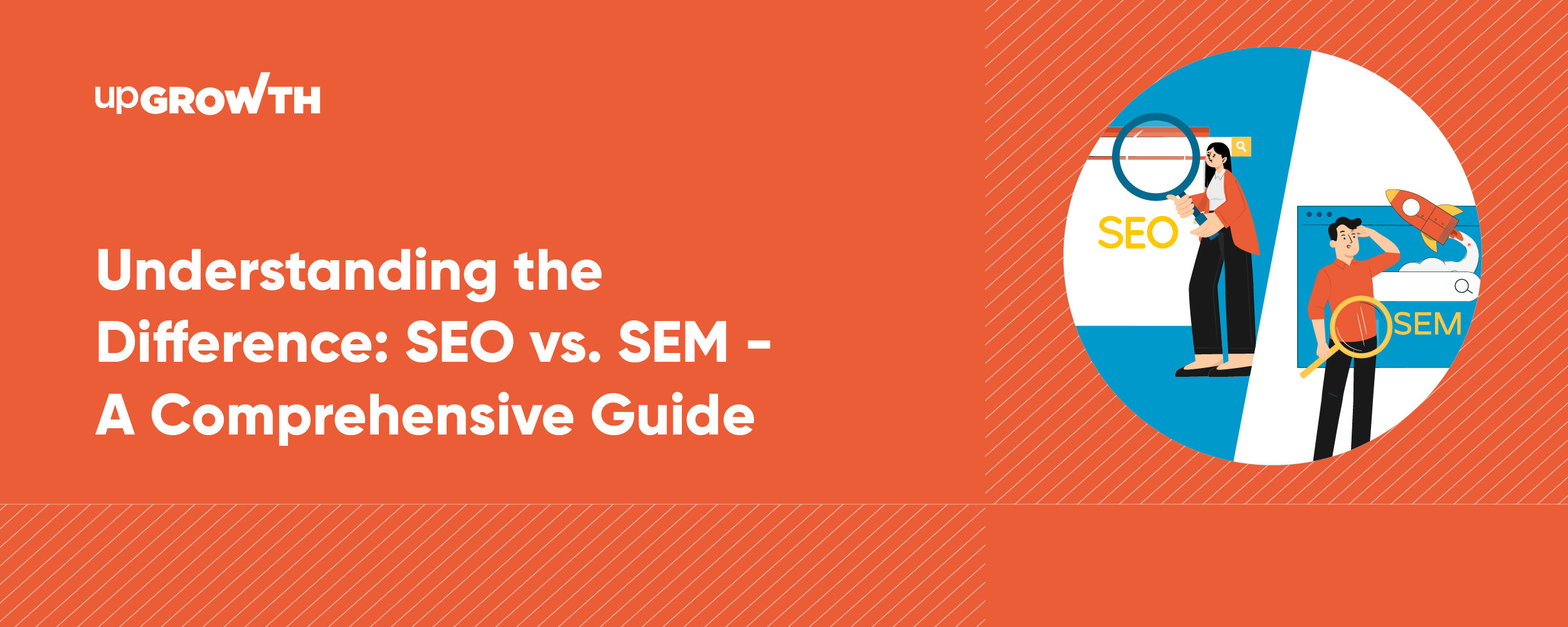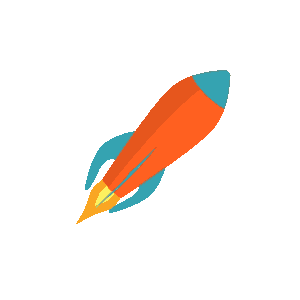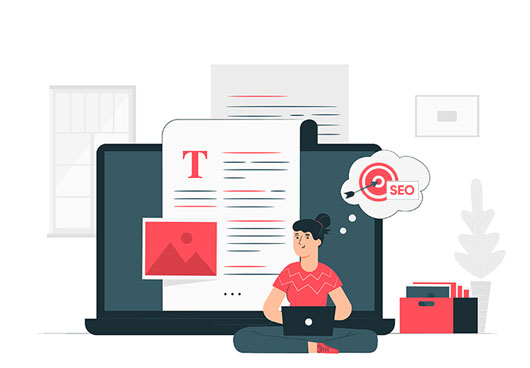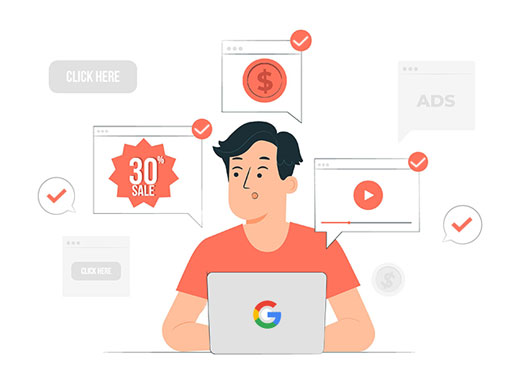Understanding the Difference: SEO vs SEM – A Comprehensive Guide
Contributors:
Amol Ghemud
Published: March 14, 2024

Navigating the landscape of search engine optimization (SEO) and search engine marketing (SEM) can often feel like deciphering a complex puzzle in digital marketing. SEO and SEM are fundamental components of a successful online marketing strategy, yet they serve different purposes and follow distinct pathways to achieve visibility and engagement.
This guide delves into the nuances of SEO vs. SEM, aiming to demystify these terms and highlight their unique advantages and applications. Let us explore the core differences, strategic uses, and synergies of SEO and SEM, providing you with the insights needed to navigate the digital marketing terrain confidently.
What is Search Engine Optimization (SEO)?
Search Engine Optimization, or SEO, is a strategic process used to improve a website’s visibility in the organic (non-paid) search engine results. SEO is about understanding what people are searching for online, the answers they are seeking, the words they’re using, and the type of content they wish to consume. By aligning your website’s content and structure with these insights, SEO aims to increase the quality and quantity of traffic through organic search engine results.
SEO encompasses a variety of tactics and best practices divided into three main categories:
- On-page SEO: Involves optimizing the content on your website to include relevant keywords and provide value to your audience.
- Off-page SEO: Primarily focuses on building authority through backlinks from other websites.
- Technical SEO: Includes website and server optimizations that help search engine spiders crawl and index your site more effectively (e.g., site speed optimization, structured data).
What is Search Engine Marketing (SEM)?
Search Engine Marketing, or SEM, is a comprehensive digital marketing strategy to increase a website’s visibility in search engine results pages (SERPs) primarily through paid advertising. SEM encompasses paid search ads, also known as pay-per-click (PPC) ads, where advertisers bid on keywords that users of services such as Google and Bing might enter when looking for certain products or services. This enables advertisers to have their ads appear alongside the search results for those queries, providing an immediate visibility boost and targeted traffic to their site.
SEM goes beyond just PPC advertising; it also includes other tasks that help optimize the paid search listings, such as ad copy optimization, landing page optimization, and keyword research to ensure the ads appear for the most relevant and profitable search queries. SEM offers quick, controllable visibility in search engines—a crucial advantage for new websites or those competing in markets with high levels of SEO competition.
SEO vs SEM: Understanding the Core Differences
SEO and SEM serve the common goal of boosting a website’s visibility in search engine results. However, their approaches, tactics, and outcomes have distinct differences. Understanding these differences is crucial for marketers developing an effective online strategy. Here’s a closer look at the core differences between SEO and SEM:
Visibility
SEO aims to increase a website’s organic search rankings for specific keywords, making it a long-term strategy to enhance visibility without directly paying for it. SEM, on the other hand, focuses on increasing visibility through paid ads in addition to organic rankings, offering immediate results and visibility in search engine results pages (SERPs).
Cost Structure
SEO costs revolve around the investment in content creation, website optimization, and link-building efforts without paying for clicks. SEM involves paying directly for visibility, typically through a pay-per-click (PPC) model where advertisers pay a fee each time their ad is clicked.
Timeframe for Results
SEO is a long-term strategy; it often takes months to see significant improvements in search rankings and organic traffic. SEM can provide immediate visibility and traffic as soon as campaigns are launched, making it ideal for brands looking for quick exposure.
Targeting and Control
SEM offers more precise targeting options through the use of keywords, ad placements, and audience targeting features. This control allows advertisers to optimize their spend and target their audience more directly. SEO, while impactful for reaching a broader audience, offers less control over who sees your listings, relying on search engine algorithms to determine your content’s relevance to users’ queries.
Sustainability
The visibility gained from SEO is more sustainable over time, as ranking well organically can provide consistent traffic without the need for ongoing payment. SEM visibility is contingent on continued ad spend, making it less sustainable without a consistent budget.
Complementarity
While SEO and SEM are often viewed as separate strategies, they complement each other effectively when used together. SEM can provide quick visibility and traffic, while SEO builds a strong organic presence over time. Together, they can enhance a website’s overall search engine presence more effectively than when used alone.
SEO vs SEM: In-depth Comparison
Diving deeper into the intricacies of SEO and SEM reveals more about how they uniquely impact a business’s online presence and marketing strategy. This comparison aims to shed light on the specific aspects where these two strategies differ, providing a more detailed perspective on their application and benefits.
Traffic Generation and Quality
SEO:
- Generates organic traffic, which users often consider more credible and trustworthy.
- Attracts visitors specifically searching for information, products, or services related to your business, leading to higher quality traffic and potentially higher engagement rates.
SEM:
- While SEM can quickly generate significant traffic through paid ads, the mix of traffic quality can vary. Since ads are marked as such, some users may skip over them, preferring organic listings.
- Allows for targeting specific demographics, potentially increasing the relevance and conversion rate among the users reached.
Visibility in Search Results
SEO:
- Achieving a high ranking in organic search results can offer sustained visibility over time.
- This requires consistent effort in content creation, optimization, and keeping up with algorithm changes.
SEM:
- Offers immediate visibility at the top of search results through paid ads.
- This is especially beneficial for new websites or competitive keywords where organic ranking is difficult to achieve quickly.
- SEM visibility is maintained as long as the budget allows.
Cost Implications and ROI
SEO:
- Limited by search engine algorithms and user search behaviors.
- While on-page and technical SEO can be optimized, the precise targeting of specific audiences is indirect.
SEM:
- Offers extensive flexibility in targeting options, including keywords, location, language, time of day, and user demographics.
- Advertisers can tailor campaigns to reach a very specific audience, making adjustments based on performance data.
Impact on Brand Awareness and Authority
SEO:
- Building organic search ranking over time can significantly enhance brand authority and credibility.
- High rankings for relevant keywords reinforce the brand’s standing as a leader in its industry.
SEM:
- Increases brand awareness quickly through visibility in paid search results.
- While it can support brand authority by association with targeted keywords, the impact on perceived credibility may not be as strong as organic listings.
Choosing the Right Strategy for Your Business
Deciding whether SEO or SEM (or a combination of both) best suits your business needs depends on various factors, including your marketing objectives, budget, and timeline. Understanding the strengths and limitations of each approach can help you make an informed decision that aligns with your business goals.
When to Use SEO
- Long-Term Growth: SEO is the way to go if your goal is to build lasting brand authority and achieve sustainable organic growth. It’s ideal for businesses looking to establish a strong online presence over time without relying on continuous ad spend.
- Limited Budget: SEO provides a cost-effective option for businesses with tighter marketing budgets. While it requires upfront investment in content and optimization, it doesn’t entail the ongoing costs associated with clicks in SEM campaigns.
- Industry Authority: SEO helps establish your business as a thought leader in your industry. High-quality content that ranks well organically enhances credibility and trust with your audience.
When to Use SEM
- Immediate Visibility: If you need quick results, such as for a product launch or a seasonal campaign, SEM can provide immediate visibility and traffic. It’s beneficial for new websites that haven’t yet built up strong organic rankings.
- Highly Competitive Markets: In industries where the SEO competition is fierce, SEM can offer a valuable edge, ensuring your business appears prominently in search results for desired keywords.
- Targeted Campaigns: When you have specific audience segments you want to reach quickly and directly, SEM’s targeting capabilities allow for precision marketing, tailoring messages to match the demographics, interests, and behaviors of your ideal customers.
Combining SEO and SEM
For many businesses, a hybrid approach that leverages both SEO and SEM strategies offers the best of both worlds. Using SEM can provide the immediate visibility and traffic needed in the short term, while SEO efforts are ramping up. Over time, as your SEO gains momentum and your organic presence strengthens, you may choose to adjust your SEM spend accordingly, using it strategically for targeted campaigns or competitive keywords.
Conclusion
While SEO is a marathon, building your brand’s authority and organic online presence over time, SEM acts as a sprint, providing immediate visibility and targeted reach. The choice between SEO, SEM, or a strategic combination depends on your business goals, budget, and market dynamics.
Embracing the strengths of each strategy can set your business up for digital marketing success. A well-rounded approach that leverages the complementary powers of SEO and SEM could be the key to unlocking your brand’s full online potential. Remember, digital marketing is not a one-size-fits-all endeavor. Continuously refine your strategies based on analytics and market feedback, ensuring your business remains agile and responsive to changes.
FAQs
1. How long does it take to see results from SEO efforts?
The time it takes to see results from SEO efforts can vary widely, but generally, businesses can start seeing noticeable improvements within 3 to 6 months. However, significant SEO results, such as ranking for competitive keywords and achieving substantial organic traffic growth, often require 6 to 12 months. SEO is a long-term strategy, and its results compound over time as your website’s authority and content library grow.
2. How long does it take to see results from SEM campaigns?
Results from SEM campaigns can be seen almost immediately after the campaign goes live. Your website can start receiving traffic from targeted keywords as soon as your ads are approved and your bids are competitive. However, optimizing SEM campaigns for the best conversion rates and cost-effectiveness might take a few weeks of adjustment and analysis.
3. Can SEO and SEM be used together in a marketing strategy?
Yes, SEO and SEM can and often should be used together in a marketing strategy. Combining these approaches leverages the strengths of each: immediate visibility from SEM and sustainable growth from SEO. This dual strategy can help cover a broader range of keywords, target different stages of the customer journey, and provide a safety net if one approach faces challenges. Together, they can enhance a brand’s overall online presence more effectively than either strategy used in isolation.
4. What are some common mistakes to avoid in SEO?
- Common mistakes to avoid in SEO include:
- Ignoring the importance of mobile optimization.
- Overlooking the user experience on your website.
- Keyword stuffing or using irrelevant keywords.
- Neglecting the quality and relevance of content.
- Failing to acquire high-quality backlinks.
- Not staying updated with search engine algorithm changes.
5. What are some common mistakes to avoid in SEM?
- Common mistakes to avoid in SEM include:
- Not using specific enough keywords, leading to irrelevant traffic.
- Overlooking negative keywords, which can help prevent ads from showing for unrelated searches.
- Ignoring the importance of ad copy and landing page relevance.
- Failing to use ad extensions to enhance ad visibility and information.
- Not continuously monitoring and adjusting bids and budgets based on campaign performance.
Read More:
SEM Rules to Follow to become an Expert
How Can You Empower Your Business? Tips for Choosing the Right SEO Package in India
Navigating SEO for Blockchain: 7 Key Trends and Practices
7 SEO Strategies for Capital Markets Financial Services Success
SEO Agency for SaaS Product: 10 Reasons Why you Need an Experienced SEO Agency
How Can You Empower Your Business? Tips for Choosing the Right SEO Package in India
About the Author
Optimizer in Chief
Amol has helped catalyse business growth with his strategic & data-driven methodologies. With a decade of experience in the field of marketing, he has donned multiple hats, from channel optimization, data analytics and creative brand positioning to growth engineering and sales.
 Growth Strategy and Planning
Growth Strategy and Planning Inbound Growth
Inbound Growth Growth Hacking
Growth Hacking Search Engine Optimization
Search Engine Optimization Paid and Performance Marketing
Paid and Performance Marketing Social Media Marketing
Social Media Marketing AI-Driven Growth Strategy
AI-Driven Growth Strategy
 Growth Tools
Growth Tools Offers
Offers


















Leave a Reply